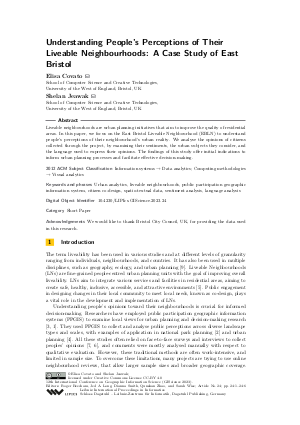LIPIcs.GIScience.2023.24.pdf
- Filesize: 7.82 MB
- 6 pages

 Creative Commons Attribution 4.0 International license
Creative Commons Attribution 4.0 International license

Liveable neighbourhoods are urban planning initiatives that aim to improve the quality of residential areas. In this paper, we focus on the East Bristol Liveable Neighbourhood (EBLN) to understand people’s perceptions of their neighbourhood’s urban reality. We analyse the opinions of citizens collected through the project, by examining their sentiments, the urban subjects they consider, and the language used to express their opinions. The findings of this study offer initial indications to inform urban planning processes and facilitate effective decision-making.












Feedback for Dagstuhl Publishing